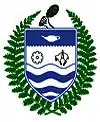| Ōpōtiki College | |
|---|---|
 | |
| Address | |
22 St John Street, Ōpōtiki 3122 | |
| Coordinates | 38°00′48″S 177°17′18″E / 38.0133°S 177.2884°E |
| Information | |
| Type | State co-educational secondary, years 9-13 |
| Motto | Te Hinengaro Te Tohu (The mind is the measure of the man) |
| Established | 1953 |
| Status | Open |
| Ministry of Education Institution no. | 148 |
| Principal | Mrs Terehia Channings |
| Age range | 13-18 |
| School roll | 322[1] (April 2023) |
| Socio-economic decile | 2D[2] |
| Website | opotikicol.school.nz |
Ōpōtiki College is a state secondary school located in Ōpōtiki, in the Bay of Plenty, North Island, New Zealand.
History
The first secondary schooling available in Ōpōtiki was at the Opotiki District High School, which was established in 1922. The name was changed in 1953 when Ōpōtiki College opened as a separate secondary school (on its present site).
When Ōpōtiki College came into being in 1953, a new crest was decided on. At the top is a burning lamp. Underneath is a cogged wheel and key. The fern and the mere were added later.
The first motto was in Latin – UT MENS ITA HOMO; “as the mind is, so is the man”. This was later changed to te reo Māori – TE HINENGARO TE TOHU; meaning “The mind is the measure of the man”.
A new logo has recently been developed that has at its centre the Koru.
Kura Ki Uta
The school marae (Maori communal space) was opened in 1981, complete with a dedicated meeting house or wharenui, given the name Kura Ki Uta. The school kapa haka roopu (Māori Performing Arts team) has taken this name too. The wharenui building burned down accidentally in 2014. The reconstructed wharenui was rededicated in 2016. The photographs of the House Leaders that had been on display in the original wharenui were saved from the fire, but the original tukutuku panels (latticework used to decorate meeting houses) were lost. The carvings on the outside were restored; the original carvings from 1981 had already been replaced. The new maihe {front facing barge boards} represent the local tribes (iwi), Whakatōhea, Tūhoe, Ngāitai and Te Whānau-ā-Apanui. The twelve heavens and ten Atua (gods) are represented on each sidearm and the centre piece, representative of Io, the Supreme being , has representations of the three baskets (kete) of knowledge in Maori tradition (Te Kete Aronui, Te kete Tuauri, and Te Kete Tuatea),[3] the influence of the Church and the influence of Maoridom. School functions are held on the marae ātea, the open space in front of the meeting house, including formal powhiri (Maori welcoming ceremony) for guests, orientation for new students and celebrations of student successes. [4]
School houses
With remarkable inclusivity the traditional school house names cover a diverse range of representatives, some of New Zealand's foremost representatives in their domains- sports, academic, science, literature, politicians, Ngati Porou, rainbow, Nobel prize winner, Victoria Cross winner.
- Freyberg House, named for Lieutenant General Bernard Freyberg
- Ngata House, named for Sir Āpirana Ngata
- Mansfield House, named for Katherine Mansfield
- Rutherford House, named for Lord Ernest Rutherford
Notable alumni
- Dylan "DJ" Collier, Olympian (2021, Sevens), NZ Sevens, 2018 Commonwealth Games Gold Medalist
- Luka Connor, Black Fern
- Exia Shelford, Black Fern
- Kate Henwood, Black Fern
- Sam Henwood, Māori All Black
- Murray Ken Hudson recipient of the George Cross
- James Rolleston, actor
- Frank Shelford, All Black, Māori All Black
- Nikki Slade Robinson, author
- Leanne Walker, Olympian, (Basketball) and NZ touch
- William Walker, Māori All Black
- Marilynn Webb, artist
References
- ↑ "New Zealand Schools Directory". New Zealand Ministry of Education. Retrieved 12 December 2022.
- ↑ "Decile Change 2014 to 2015 for State & State Integrated Schools". Ministry of Education. 29 November 2013. Retrieved 12 February 2015.
- ↑ Taonga, New Zealand Ministry for Culture and Heritage Te Manatu. "Ranginui as knowledge and life". teara.govt.nz. Retrieved 3 June 2021.
- ↑ "Fire at Opotiki College". 14 June 2014.